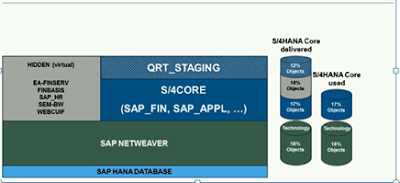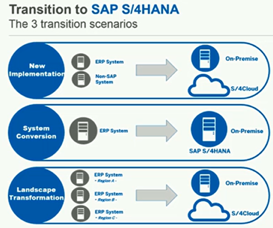“S4HANA”, the new generation business suite has already arrived and am one of the lucky chaps to have a hands-on.
As you know there is lot of material on help.sap.com and SCN to provider a deeper insight on the product, I think I read all of it and want to put everything in this blog. Well that was sarcasm, in this blog I will summarize my view point as a Technology consultant interested in technology stack and migration paths and scenarios.
Architectural changes:
“If we have many ways to achieve the very same thing, then we lack standardization on the product”
If you want to give me all the credit for the phrase then please....
Well not my words, I picked it form one of the speaker at a conference. They really make sense.
Many people might disagree with the above statement but the argument I have is, we need to invest in many product which give me same functionality.
S4HANA is re-imaged business suite to re-image your business. SAP say they used "principle of one" in building S4HANA.
Let’s have a look what’s changed in the underlying architecture? How is it different from traditional Business suite?
Traditional Business Suite:
As you know there is lot of material on help.sap.com and SCN to provider a deeper insight on the product, I think I read all of it and want to put everything in this blog. Well that was sarcasm, in this blog I will summarize my view point as a Technology consultant interested in technology stack and migration paths and scenarios.
Architectural changes:
“If we have many ways to achieve the very same thing, then we lack standardization on the product”
If you want to give me all the credit for the phrase then please....
Well not my words, I picked it form one of the speaker at a conference. They really make sense.
Many people might disagree with the above statement but the argument I have is, we need to invest in many product which give me same functionality.
S4HANA is re-imaged business suite to re-image your business. SAP say they used "principle of one" in building S4HANA.
Let’s have a look what’s changed in the underlying architecture? How is it different from traditional Business suite?
Traditional Business Suite:
Latest Enhancement pack is EPH8 which is in GA and available for any DB, but from here on SAP’s strategy is that there will not be any EHP’s it will be replaced by S4CORE component.
S4HANA
What happens in S4HANA?
*Hidden – These components are no longer developed but you can use them if needed.
SAP_FIN and SAP_APPL is no longer separate SC’s but built into S4CORE, so as an admin one less thing to worry when patching the system.
Well, if the architecture changed then how about the code? Do I need to tweak the code or can I use the existing code? Well in some case yes but S4HANA minimises it, let’s see how?
SAP uses CDS – Core Data Services compatibility views.
As we know the programs are written referencing the data models, in S4HANA we have compatibility views which have the same references as the old data models but the data is populated on the fly. The program wouldn’t care less if they are calculated on the fly, all they need is data.
The following figure explains more about the CDS compatibility views
Everything is accessible only through Fiori in S4HANA, well that not the case, we can still use SAP GUI with on-premise edition.
Migration Paths to S4HANA
There are three transition scenarios to SAP HANA
New Implementation or Re-Implementations
This scenario is for Green-Field implementation where you migrate non-SAP to S4HANA or perform data migration from SAP ERP to S4HANA on-premise or Cloud.
Tools used:
- Non-SAP system to S4HANA – File/Object based template upload.
- SAP Systems to S4HANA – SAP SLT
System Conversions
This scenario is for Brown-Field implementation where customers are already running on-premise ERP system on AnyDB/SAP HANA DB migrating to S4HANA.
In this scenario we cannot migrate to cloud because, it’s a lift and shift of existing system and this might not be compatible with the S4HANA cloud
principles or solutions as we need to retain the existing customization.
Tools Used:
Software Update Manager with DMO option.
I know there would be lot of questions around from which versions of SAP ERP we can migrate to S4HANA, I would not comment on it because SAP might add/remove the product versions. So the best place is to look at is PAM or Service market place.
Landscape Transformation
This scenario is also for Brown-Felid implementation where customers are already running on-premise ERP system on AnyDB and migrate to SAP S4HANA or merge different ERP systems to single S4HANA on cloud/on-premise.
Tools used:
- SAP LT
This option would be more suitable for business merger scenario where the reduction of landscape would be more efficient to cut IT costs.
Well, It's with the Customers and Consultant to consider which scenario best suits their business need. Each customer scenario is different and the migration path should be carefully chosen in consultation with SAP.
What difference I have seen in the system?
- Memory Utilization – In our labs we have installed S4HANA on 128GB server, we noticed S4HANA (1511) is a bit more intensive than SoH. So I wouldn’t consider a 128GB box for Dev & Test Environment and would prefer 256GB appliance (This is purely my view).
- You can no longer find 001 and 006 clients; it comes with only 000 Client.
- More importantly if you want to use Apps for SAP Activate you need to install the add-on UIS4HOP1.
- You need to update the SLD if you want to apply the SPS otherwise LMDB doesn’t recognize the products.
Source: scn.sap.com






No comments:
Post a Comment